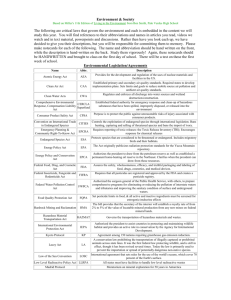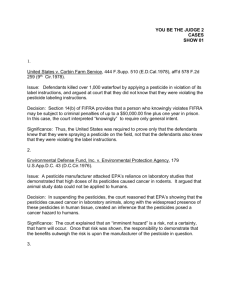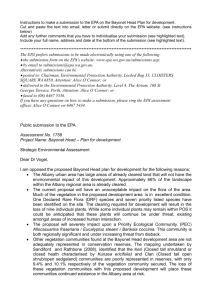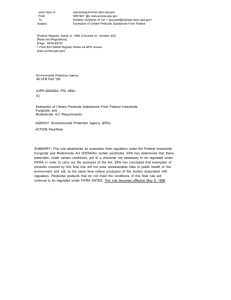Apes Laws - Mira Costa High School
advertisement
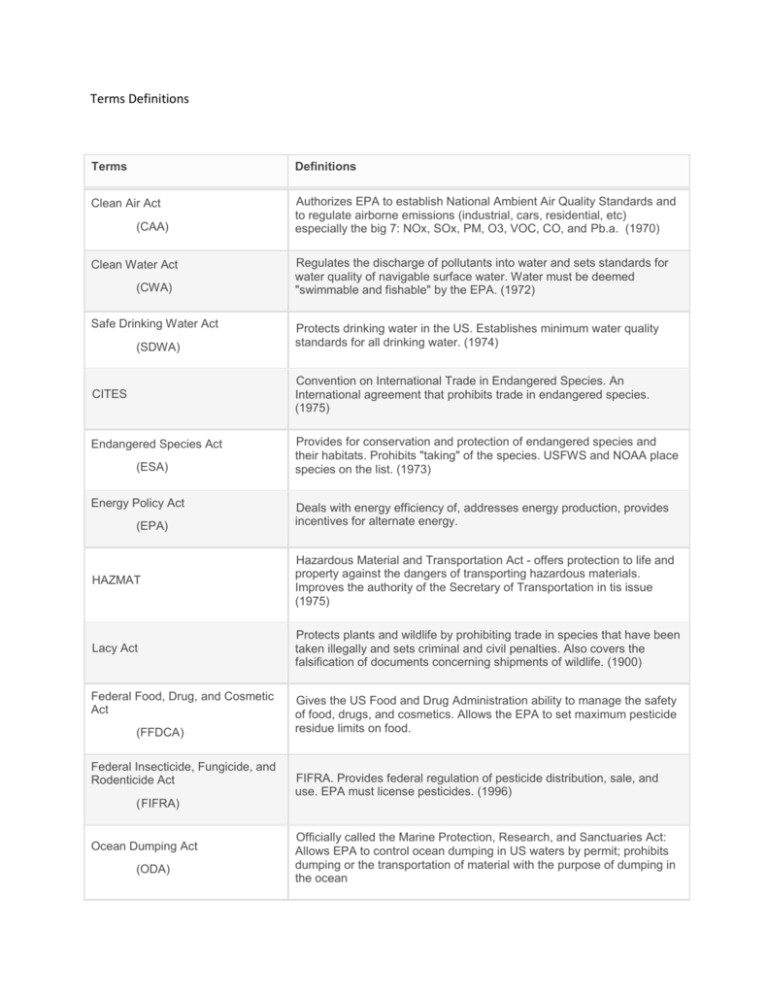
Terms Definitions Terms Definitions Clean Air Act Authorizes EPA to establish National Ambient Air Quality Standards and to regulate airborne emissions (industrial, cars, residential, etc) especially the big 7: NOx, SOx, PM, O3, VOC, CO, and Pb.a. (1970) (CAA) Clean Water Act (CWA) Safe Drinking Water Act (SDWA) Regulates the discharge of pollutants into water and sets standards for water quality of navigable surface water. Water must be deemed "swimmable and fishable" by the EPA. (1972) Protects drinking water in the US. Establishes minimum water quality standards for all drinking water. (1974) Convention on International Trade in Endangered Species. An International agreement that prohibits trade in endangered species. (1975) CITES Endangered Species Act (ESA) Energy Policy Act (EPA) Provides for conservation and protection of endangered species and their habitats. Prohibits "taking" of the species. USFWS and NOAA place species on the list. (1973) Deals with energy efficiency of, addresses energy production, provides incentives for alternate energy. HAZMAT Hazardous Material and Transportation Act - offers protection to life and property against the dangers of transporting hazardous materials. Improves the authority of the Secretary of Transportation in tis issue (1975) Lacy Act Protects plants and wildlife by prohibiting trade in species that have been taken illegally and sets criminal and civil penalties. Also covers the falsification of documents concerning shipments of wildlife. (1900) Federal Food, Drug, and Cosmetic Act (FFDCA) Federal Insecticide, Fungicide, and Rodenticide Act Gives the US Food and Drug Administration ability to manage the safety of food, drugs, and cosmetics. Allows the EPA to set maximum pesticide residue limits on food. FIFRA. Provides federal regulation of pesticide distribution, sale, and use. EPA must license pesticides. (1996) (FIFRA) Ocean Dumping Act (ODA) Officially called the Marine Protection, Research, and Sanctuaries Act: Allows EPA to control ocean dumping in US waters by permit; prohibits dumping or the transportation of material with the purpose of dumping in the ocean Nuclear Waste Policy Act (NWPA) Occupational Safety and Health Act (OSHA) Pollution Prevention Act (PPA) Resource Conservation and Recovery Act (RCRA) Enacted to manage the disposal of nuclear waste. Allows deep geological depositories for the disposal of radioactive waste. (1982) OSHA - ensures workplace safety and health. Helps prevent work injuries, illnesses, and fatalities. (1970) Helps individuals, organizations, and industry to reduce their pollution. Focuses on source reduction. (1990) Resource Conservation and Recovery Act. Controls the transport, treatment, and storage of the waste. Gives EPA authority to manage waste from cradle to grave. (1976) Solid Waste Disposal Act Controls how solid waste is disposed of. (1965) (SWDA) Soil Conservation Act (SCA) Surface Mining Control and Reclamation Act ASDA must plan for soil conservation. Allows the government to pay farmers to reduce production to conserve soil. (1936) Controls the environmental effects of coal mining... regulates existing mines and provides for reclaiming abandoned mines. (1977) (SMCRA) Taylor Grazing Act (TGA) Enacted to improve conditions of rangelands by regulating grazing on public lands. (1934) Kyoto Protocol An international agreement aimed at reducing the effects of climate change by setting targets to reduce greenhouse gas emissions. US is one of only a few nations that never ratified it. (1997) Montreal Protocol International treaty that phases out the use of CFC's and other ozone depleting emissions to help protect the ozone layer. (1989) National Environmental Policy Act National Environmental Policy Act... formed the EPA (1969) (NEPA) Wilderness Act Comprehensive Enviromental Response, Compensation and Liablility Act (CERCLA) Protects large areas of land from development, establishes the definition of wilderness. Also created the National Wilderness Preservation System (1964) Also known as the "Superfund Act". Provides for the cleanup of the worst contaminated sites by setting up a national trust fund Animal Damage Control (ADC) Rivers and Habors Act (RHA) The Federal Land Policy Management Act Provided a broad authority of investigation, and demonstrations and control of mammalian predators, rodents and birds. (1985) Makes it a misdemeanor to excavate fill, or alter course, condition, or capacity of any port, harbor, channel, or other areas within the reach of the Act without a permit. (1899) Governs the way that Public land is administered by the bureau of Land Management are managed. (1976) (FLPMA) Toxic Substances Control Act (TSCA) The Federal Insecticide, Fungicide, and Robenticide Act Regulates the introduction of new or already exisiting chemicals. Prohibits the manufacture or importation of chemicals that are not on the TSCA inventory(or subject to one or many exemptions) (1976) System of pesticide regulation to protect applicators, consumers and the Environment. This act is regulated by the EPA. (1947) (FIFRA) Fish and Wildlife Coordination Act (FWCA) Put into into action to protect fish and wildlife when federal actions in the control or modification of a natural stream or body of water.(1934)



